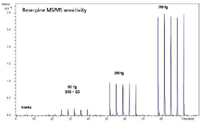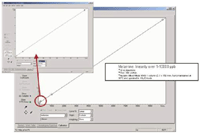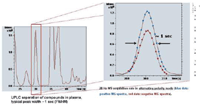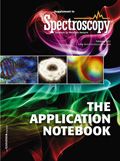Analysis of Small Molecules with amaZon: Enhanced Sensitivity, Speed, and Dynamic Range
Application Notebook
The amaZon series is the next step in Bruker Daltonics' family of ion trap mass spectrometers.
Darwin Asa, Bruker Daltonics, Inc.
The amaZon series is the next step in Bruker Daltonics' family of ion trap mass spectrometers. Incorporating a number of new innovations to Bruker's highly successful ion trap technology platforms, the amaZon series is a true leap forward in performance and reliability.

Figure 1: Direct injection of 50â750 fg Reserpine. Even at 50 fg in MS-MS mode, the amaZon is able to achieve at 50:1 S/N. Note also the excellent reproducibility in these 5 replicate injections.
Building upon Bruker's vast foundation of expertise with ion traps, the amaZon series of instruments features a number of key performance enhancements including:
- Greater than 10× sensitivity improvement over previous generation systems
- Outstanding mass resolution of up to 20,000
- Extraordinarily broad mass range from 50 to 3,000 m/z
- Rapid scan speeds of up to 52,000 μs allowing full compatibility with fast separation techniques
- The very latest in ETD/PTR technology for analysis of post translational modifications of peptides or proteins
- High speed ion polarity switching for handling difficult or complex samples
- Comprehensive MSn spectral libraries for easy molecular formula determinations

Figure 2: Dynamic range of amaZon. In this example 1â10,000 ppb of melamine on column was measured by the amaZon. This correlates to at least 4 orders of magnitude dynamic range with outstanding linearity.
The amaZon series is available in 3 versions:
amaZon ETD for protein analysis.
amaZon X for all protein and small molecule applications.
amaZon SL for small molecule and protein applications at a value price.
Designed for key applications in chemical reaction yield and purity determinations, proteomics, protein and glycan analysis, metabolomics, compound screening, and compound identification, the amaZon series is the top performing ion trap available today.

Figure 3: Speed of amaZon. In this example, a compound in plasma separated by UPLC with a 1 s peak width is measured at 20 Hz in positive and negative ion mode with "zero delay" alternating ionization switching.
The performance of the amaZon X Ion Trap System has been tested in terms of sensitivity, speed, and dynamic range for small molecule analysis. It has been shown that the amaZon is easily capable of detecting low femtagrams of a small molecule on column. The amaZon also displays at least four orders of magnitude dynamic range when quantitating small molecules in the ppb to ppm range. The instrument also possesses the capability to do "zero delay" polarity switching, even at UPLC separation speeds. All of these attributes demonstrate the high performance capabilities of the amaZon and demonstrate it's suitability for deployment in a number of small molecule analysis areas.

Bruker Daltonics, Inc.
40 Manning Road, Billerica, MA 01821
tel. (978) 663-3660; fax (978) 667-5993
Website: www.bdal.com

High-Speed Laser MS for Precise, Prep-Free Environmental Particle Tracking
April 21st 2025Scientists at Oak Ridge National Laboratory have demonstrated that a fast, laser-based mass spectrometry method—LA-ICP-TOF-MS—can accurately detect and identify airborne environmental particles, including toxic metal particles like ruthenium, without the need for complex sample preparation. The work offers a breakthrough in rapid, high-resolution analysis of environmental pollutants.
Thermo Fisher Scientists Highlight the Latest Advances in Process Monitoring with Raman Spectroscopy
April 1st 2025In this exclusive Spectroscopy interview, John Richmond and Tom Dearing of Thermo Fisher Scientific discuss the company’s Raman technology and the latest trends for process monitoring across various applications.
A Seamless Trace Elemental Analysis Prescription for Quality Pharmaceuticals
March 31st 2025Quality assurance and quality control (QA/QC) are essential in pharmaceutical manufacturing to ensure compliance with standards like United States Pharmacopoeia <232> and ICH Q3D, as well as FDA regulations. Reliable and user-friendly testing solutions help QA/QC labs deliver precise trace elemental analyses while meeting throughput demands and data security requirements.